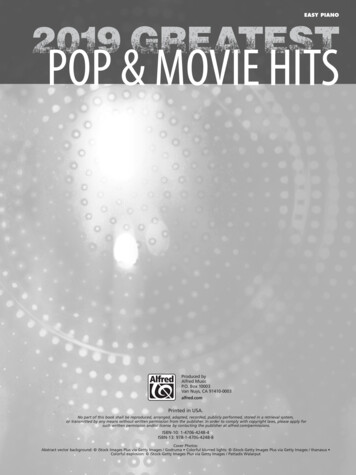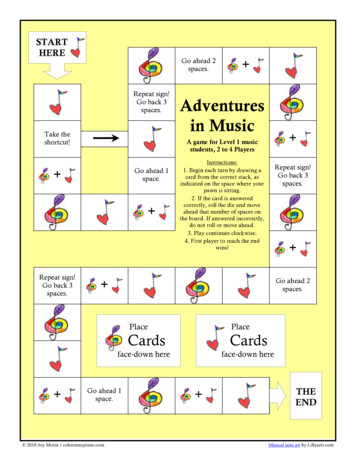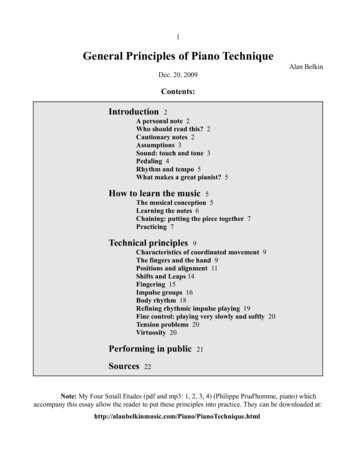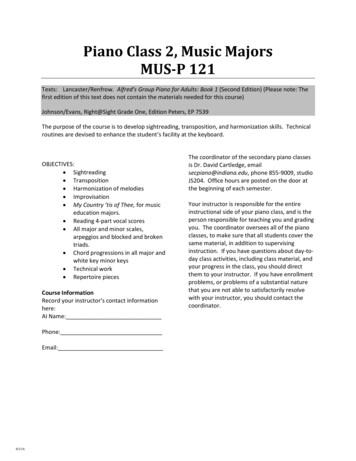
Transcription
Piano Class 2, Music MajorsMUS-P 121Texts: Lancaster/Renfrow. Alfred’s Group Piano for Adults: Book 1 (Second Edition) (Please note: Thefirst edition of this text does not contain the materials needed for this course)Johnson/Evans, Right@Sight Grade One, Edition Peters, EP 7539The purpose of the course is to develop sightreading, transposition, and harmonization skills. Technicalroutines are devised to enhance the student’s facility at the keyboard.OBJECTIVES: Sightreading Transposition Harmonization of melodies Improvisation My Country ’tis of Thee, for musiceducation majors. Reading 4-part vocal scores All major and minor scales,arpeggios and blocked and brokentriads. Chord progressions in all major andwhite key minor keys Technical work Repertoire piecesCourse InformationRecord your instructor’s contact informationhere:AI Name:Phone:Email:8/1/16The coordinator of the secondary piano classesis Dr. David Cartledge, emailsecpiano@indiana.edu, phone 855-9009, studioJS204. Office hours are posted on the door atthe beginning of each semester.Your instructor is responsible for the entireinstructional side of your piano class, and is theperson responsible for teaching you and gradingyou. The coordinator oversees all of the pianoclasses, to make sure that all students cover thesame material, in addition to supervisinginstruction. If you have questions about day-today class activities, including class material, andyour progress in the class, you should directthem to your instructor. If you have enrollmentproblems, or problems of a substantial naturethat you are not able to satisfactorily resolvewith your instructor, you should contact thecoordinator.
Page 2, MUS-P 121STUDENT RESPONSIBILITIESJury and Hearing dates: As juries and hearings areone-on-one events, they are scheduled outside ofclass time, by appointment with your instructor.Your instructor will likely arrange a time during class,by email, or by posting a signup sheet. Theapproximate dates of these events are set forth inthe following syllabus. If you have a conflict withany of these dates, let your instructor know early.Instructors are not obligated to make up juries andhearings.Preparation: This syllabus is devised so that you canprepare for class material ahead of time. Forexample, you are expected to have preparedmaterial for week three, and be ready to play it forthe first class period of that week. Your instructorwill announce those items required for preparationfor each class period, and it is expected that you willprepare these items. If you are absent for anyreason, it will be assumed that you are using thissyllabus to keep up with class content.Practice: It is expected that students in secondarypiano classes will practise an average of 30 to 40minutes per day. Some students will require moretime, others less. Do NOT try to “cram” at the lastminute. Piano playing, like any physical skill,requires continual reinforcement, and cannot be“crammed.” Practice time can be scheduled tmlParticipation: This is a laboratory environment. Itcannot function if students are not prepared, or aredistracting. Therefore, points are assigned forparticipation in class. If you are absent, late,unprepared, or uncooperative in class, yourinstructor will assess you accordingly.Need help? Your instructor keeps office hours, eitherat a particular time, or by appointment. Make use ofthese hours—get your money’s worth from theclass!Disabilities: If you require assistance or appropriateacademic accommodations for a disability, pleasecontact the instructor after class, during office hoursor by individual appointment. You must haveestablished your eligibility for disability supportservices through the Office of Disability Services forStudents in W302 Wells Library, 855-7578.Religious Observances: If a jury, hearing orassignment is scheduled on a religious holiday youobserve, please inform your instructor during thefirst two weeks of class so that reasonableaccommodations can be made.GRADING SYSTEMTogether, jury, hearing and instructional days total400 points:Daily class scores:3 hearings at 30 points each:1 Midterm jury:1 Final jury:130 points90 points90 points90 pointsUp to 5 points are assigned for each instructionalday. These points are at the discretion of theinstructor and reflect attendance, participation andpreparation. Your attendance at the class is mostimportant for your progress as well as assessment.Your lowest two class day scores will be droppedfrom calculation of your grade. This dropping ofyour lowest two scores is intended to provideprotection against missed class days due to illness orequivalent need. All class days which are missed willbe scored zero. Students who add the class late willhave classes scored beginning at the date ofregistration.Your grade will be figured as follows:A 392 or aboveC 319-304A391-376C303-292A-375-360C-291-280B 359-344D 279-264B343-332D263-252B-331-320D-251-240F239 or below
MUS-P 121, Page 3Class time is NOT for practice. You should come to class prepared.WEEK ONEBasics:Sightreading andtransposition:Technique:Minor scales, p. 183Natural, harmonic and melodic minor scales, pp. 184–185Right@Sight (chosen by instructor)Alfred pp. 192–193 nos 1 and 3pp. 186–189Review C, G, D, A, E, F, B, G , D major scales and arpeggios (see pp. 124–126; 142–143 and 347–348), and blocked and broken chords inthese keys.Improvisation:Literature:WEEK TWOWayfaring Stranger [optional, at instructor’s discretion], pp. 194–195Little Fantasy Study, p. 191Instructor announces material for first Triads of the key in Harmonic minor, p. 196Right@Sight (chosen by instructor)Alfred p. 204–5 nos. 1 and 4p. 206p. 197Group 1 harmonic minor scales and arpeggios : A, E, D, G and C minors, pp.198–201, and blocked and broken chords.Continue C, G, D, A, E, F, B, G , D major scales and arpeggios, and blockedand broken chords.Harmonization andTransposition:Literature:p. 203 nos. 1 and 2Allegretto, p. 202
Page 4, MUS-P 121WEEK THREEBasics:Sightreading e:FIRSTHEARINGChord progressions in minor keys, p. 210Right@Sight (chosen by instructor)Alfred pp. 214–215 nos 2 and 4Continue C, G, D, A, E, F, B, G , D major scales and arpeggios, and blockedand broken chords; and A, E, D, G and C harmonic minor scales andarpeggios.Ensemble, pp. 212–213Etude, p. 211The Hearing takes place outside of class, by appointment with yourinstructor. Hearing Content to be announced by your instructor atthe beginning of Week 2WEEK FOURBasics:Sightreading andtransposition:Technique:Harmonic Minor triads of the key, p. 220Right@Sight (chosen by instructor)Alfred pp. 225 nos 1 and 2p. 221Group 2 harmonic minor scales and arpeggios: B and F minors, pp. 222–223, and blocked and broken chords.Continue C, G, D, A, E, F, B, G , D major scales and arpeggios, and blockedand broken chords; and A, E, D, G and C harmonic minor scales andarpeggios, and blocked and broken chords.Harmonization:Improvisation:Literature:All the Pretty Little Horses, p. 226p. 229, no. 2Etude in C Major, p. 263
MUS-P 121, Page 5WEEK FIVEInstructor announces material for second hearingBasics:Sightreading andTransposition:Technique:Playing Triads of the Key, p. 230Right@Sight (chosen by instructor)Alfred pp. 234–235 nos. 1 and 4Group 3 Major Scales and Arpeggios, and blocked and broken chords: B ,E , and A , pp. 231–232Continue scales, arpeggios, blocked and broken chords 2 octaves in C, G, D,A, E, F, B, G , D majors and all white key minors.Harmonization:Literature:p. 236 nos. 1 and 2Dance, p. 238WEEK SIXBasics:Sightreading e:SECONDHEARINGThe ii chord and chord progressions, pp. 241–242Right@Sight (chosen by instructor)Alfred pp. 246–247 nos. 1 and 3Scales, arpeggios, blocked and broken chords 2 octaves, in all major keys,and all white key minors.Ensemble, pp. 244–245Waltz, p. 243The Hearing takes place outside of class, by appointment with yourinstructor. Hearing Content to be announced by your instructor atthe beginning of Week 5
Page 6, MUS-P 121WEEK SEVENBasics:Sightreading tion:Literature:WEEK EIGHTThe vi chord and chord progressions, pp. 252–253Right@Sight (chosen by instructor)Alfred pp. 256–7, nos. 1, 2 and 4Scales, arpeggios, blocked and broken chords 2 octaves, in all major keys,and all white key minors.p. 258, no. 1;p. 260p. 255Ecossaise, p. 254Reminder: midterm jury is coming up!Basics:Sightreading tion:Literature:The iii chord, and chord progressions, pp. 261–262Right@Sight (chosen by instructor)Alfred pp. 264–265 nos. 1, 3 and 4 (remember to use pedal as marked)Scales, arpeggios, blocked and broken chords 2 octaves, in all major keys,and all white key minors.p. 266 nos. 1 and 2p. 269 no. 1The Cuckoo, p. 224Dance (duet), pp. 270–271. Instructor will assign parts.
MUS-P 121, Page 7WEEK NINE:ReviewThe midterm jury will be arranged by appointment with your instructor,and will be heard by a panel of Instructors. It should take place towardsthe end of Week 9. The content and breakdown of points will be asfollows:MIDTERMJURYRepertoire: 25 pointsYou will prepare 2 pieces chosen by your instructor, andcovered in the syllabus so far.Technical work: 20 pointsScales, arpeggios, blocked and broken chords 2 octaves, inall major keys, and all white key minors.Sight Reading: 15 pointsHarmonization: 15 pointsAt the beginning of week 9, your instructor will assign youseveral harmonization melodies, from which will be drawnthe example for the jury.Transposition: 15 pointsAt the beginning of week 9, your instructor will assign amelodic line, ahead of time, which you should be ready totranspose into any of several designated keys.
Page 8, MUS-P 121WEEK TENNote: Music Education Majors should start learning My Country ’Tis ofThee right away—it is part of the final jury for these majors.Basics:Sightreading e:WEEK ELEVENPlaying triads in the key, p. 272Right@Sight (chosen by instructor)Alfred p. 278 (titled “technique”) nos. 1 and 4p. 279 nos. 1 and 2Group 3 harmonic minor scales and arpeggios: F , C , G , B and E , pp.273–275, and blocked and broken chords.Continue scales, arpeggios, blocked and broken chords 2 octaves, in allmajor keys, and all white key minors.p. 280 no. 1Theme from the Moonlight Sonata, pp. 276–277Instructor announces material for third :Improvisation:Literature:Seventh chords: pp. 284–285Right@Sight (chosen by instructor)Alfred p. 289 nos. 1 and 2p. 288 nos. 1 and 2 on G7, C7, and D7.Scales, arpeggios and blocked and broken chords in all major keys, and allharmonic minor keys.p. 294: Prelude in Sevenths (ensemble)p. 295 no. 1Full Moon Rising, pp. 290–291
MUS-P 121, Page 9WEEK Literature:THIRDHEARINGThe Chromatic Scale, p. 297The Whole Tone Scale, p. 300The Blues Scale, p. 302Right@Sight (chosen by instructor); Alfred p. 297, p. 300, p. 303Scales, arpeggios and blocked and broken chords in all major keys, and allharmonic minor keys.p. 304The Bear, p. 301This takes place outside of class, by appointment with yourinstructor. Content to be announced by your instructor at thebeginning of Week 11WEEK n:Modes: Ionian, p. 305; Lydian, p. 306; Mixolydian, p. 308; Æolian, Dorian, p.310; and Phrygian, p. 314Scales, arpeggios and blocked and broken chords in all major keys, and allharmonic minor keys.Right@Sight (chosen by instructor); Alfred p. 308; p. 311p. 307Transposition:Dorian scale, p. 310Improvisation:p. 315Literature:Chromatic Rag, pp. 298–299
Page 10, MUS-P 121WEEK FOURTEENBasics:Sightreading andtransposition:Technique:Reminder: final jury is coming up!Chord progressions, p. 316Right@Sight (chosen by instructor)Alfred pp. 318–319 nos. 2 and 4Scales, arpeggios and blocked and broken chords in all major keys, and allharmonic minor keys.Harmonization:p. 320 no. 2Improvisation:p. 322 no. 2Literature:Ecossaise, p. 317WEEK FIFTEENReviewThis jury will take place at the end of Week 15, with signup arranged byyour instructor, and will be heard by a panel of Instructors. The contentand breakdown of points will be as follows:FINALJURYRepertoire: 25 pointsYou will prepare 2 pieces chosen by your instructor, andcovered in the last weeks of the syllabus. Music Educationmajors must use My Country ‘Tis of Thee as a repertoirepiece.Technical work: 20 pointsAll Major and minor technique, 2 octaves: Scales, arpeggios,blocked and broken chords—all 24 keys.Sight Reading: 15 pointsHarmonization: 15 pointsAt the beginning of week 15, your instructor will assign youseveral harmonization melodies, from which will be drawnthe example for the jury.Transposition: 15 pointsAt the beginning of week 15, your instructor will assign apiece, ahead of time, which you should be ready totranspose into any of several designated keys.
MUS-P 121, Page 11The Complete Guide to Fingering for the Class Piano StudentScaleBlocked/ BrokenChordsTonicArpeggioDom. 7thArpeggioDim. 7thArpeggioRH 2312341RH 135 125 135RH 412RH 4123RH 4123LH 3214321LH 531 531 521LH 214LH 4321LH 3214MAJORBlack-key groupsD /C majorsG /F majorsC /B majorsC Major fingeringC majorRH 2341231”RH 1 23RH 2341”LH 4321321”LH (1)32LH 4321”RH 1 231234””RH 1 234RH 1 234LH (1)321432””LH (1)432LH (1)432RH 1 231234LH (1)432132””RH 1 23LH (1)42””””””””””””G major””””D major””””A major””””””””E major””””””””RH 1234LH 2143RH 3412312”RH 412RH 4123RH 4123LH 3214321”LH 214LH 2143LH 4321RH 3123412”””RH 3412LH 3214321”””LH 4321RH 4123123”RH 412RH 4123”LH 3214321”LH 321LH 3214”RH 1 234123LH (1)432132””RH 1 23LH (1)42RH 1234LH 3214A major””””RH 1
Piano Class 2, Music Majors MUS-P 121 Texts: Lancaster/Renfrow. Alfred’s Group Piano for Adults: ook 1 (Second Edition) (Please note: The first edition of this text does not contain the materials needed for this course) Johnson/Evans, Right@Sight Grade One, Edition Peters, EP 7539 The purpose of the course is to develop sightreading, transposition, and harmonization skills. Technical .
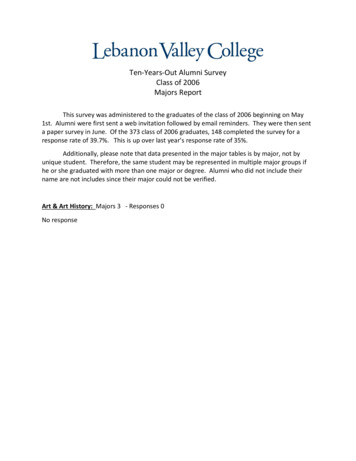
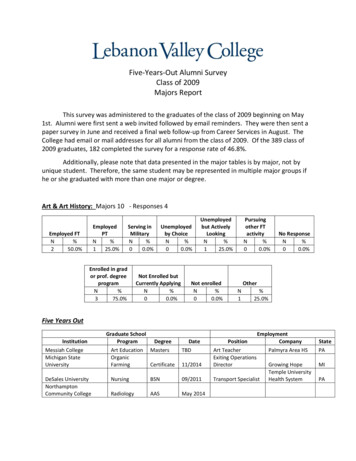

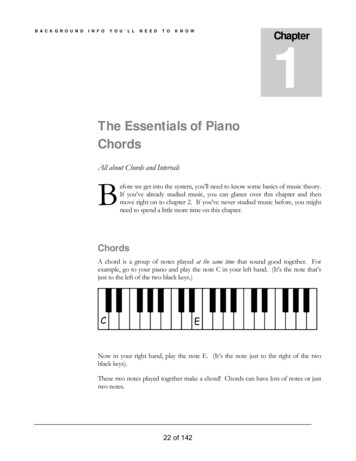
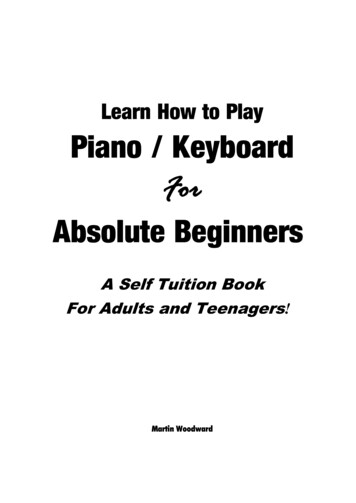
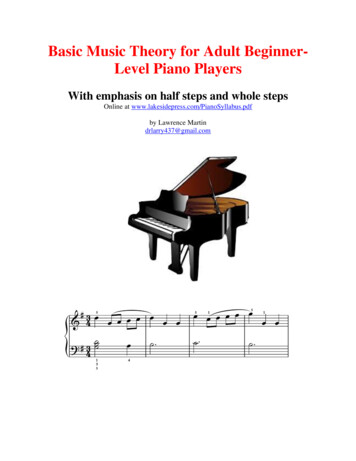
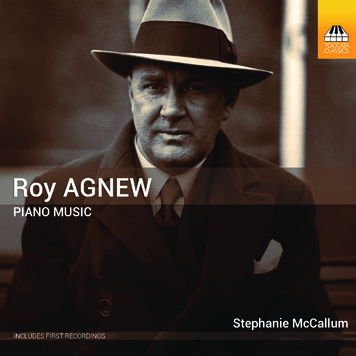
![Roman Statkowski [1859-1925] Piano Music](/img/3/25129booklet.jpg)

